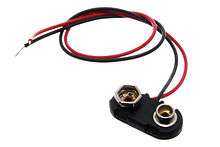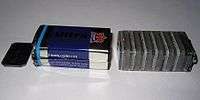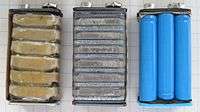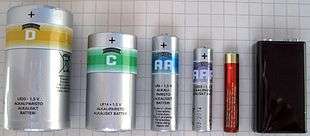Nine-volt battery
The nine-volt battery, or 9-volt battery, is a common size of battery that was introduced for the early transistor radios. It has a rectangular prism shape with rounded edges and a polarized snap connector at the top. This type is commonly used in walkie-talkies, clocks and smoke detectors.
.jpg)
The nine-volt battery format is commonly available in primary carbon-zinc and alkaline chemistry, in primary lithium iron disulfide, and in rechargeable form in nickel-cadmium, nickel-metal hydride and lithium-ion. Mercury-oxide batteries of this format, once common, have not been manufactured in many years due to their mercury content. Designations for this format include NEDA 1604 and IEC 6F22 (for zinc-carbon) or MN1604 6LR61 (for alkaline). The size, regardless of chemistry, is commonly designated PP3—a designation originally reserved solely for carbon-zinc, or in some countries, E or E-block.[1]
Most nine-volt alkaline batteries are constructed of six individual 1.5 V LR61 cells enclosed in a wrapper.[2] These cells are slightly smaller than LR8D425 AAAA cells and can be used in their place for some devices, even though they are 3.5 mm shorter. Carbon-zinc types are made with six flat cells in a stack, enclosed in a moisture-resistant wrapper to prevent drying. Primary lithium types are made with three cells in series.[3]
9-volt batteries accounted for 4% of alkaline primary battery sales in the United States in 2007, and 2% of primary battery sales and 2% of secondary battery sales in Switzerland in 2008.[4][5]
History
Historically, the now popular PP3 battery size was a member of the PP (Power Pack) battery series that was originally manufactured by Ever Ready in the United Kingdom and Eveready in the United States. The company claims that it introduced the PP3 battery in 1956,[6] then it was added as an ANSI standard in 1959, currently known as ANSI-1604A.[7] The PP (Power Pack) battery series consisted of PP1, PP3, PP4, PP6, PP7, PP8, PP9, PP10, PP11. The PP1 and PP8 were 6 volt, the PP11 was two 4.5 volt batteries, and other PP members were 9 volt, including the PP3. Today, only the PP3, PP6, PP7, PP9 sizes can still be purchased, with the PP3 being extremely common.
Before the mid-1950s, in the days of vacuum tube (valve) radios used batteries designed specifically for vacuum tubes, there was a nine-volt grid bias battery or (US) "C" battery, which had taps for various voltages between 1.5 volts and 9 volts.
Early transistorized radios and other equipment needed a suitable voltage miniature battery. Early transistor radios required a 22 1⁄2 volt battery. Although the transistors would theoretically operate from lower voltages, in 1954, the point contact transistors had to be operated very close to their VCB0 limit in order to get the required frequency response. However, a suitable miniature battery was already marketed for (vacuum tube) hearing aids. As transistors rapidly improved, particularly when alloy transistors were introduced, radios were able operate from lower voltages and the battery manufacturers introduced suitable batteries as the demand arose.
The PP3 (physically identical to 6LR61 or 1604A) appeared when portable transistor radios became common, and is still called a "transistor" battery by some manufacturers.
Connectors

The battery has both terminals in a snap connector on one end. The smaller circular (male) terminal is positive, and the larger hexagonal or octagonal (female) terminal is the negative contact. The connectors on the battery are the same as on the load device; the smaller one connects to the larger one and vice versa.[2] The same snap-style connector is used on other battery types in the Power Pack (PP) series. Battery polarization is normally obvious, since mechanical connection is usually only possible in one configuration.
A problem with this style of connector is that it is very easy to connect two batteries together in a short circuit, which quickly discharges both batteries, generating heat and possibly a fire.[8] Because of this hazard, nine-volt batteries should be kept in the original packaging until they are going to be used.[9]
Technical specifications




The most common type of nine-volt battery is often called a 9-volt, although there are less common nine-volt batteries of different sizes. Codes for the usual size include PP3 (for size and voltage, any technology), 6LR61 (IEC code for alkaline batteries), and in Japan 006P.
The PP3 size battery is 48.5 mm × 26.5 mm × 17.5 mm or 1.91 in × 1.04 in × 0.69 in. Both terminals are at one end and their centers are 0.5 inches (12.7 mm) apart.
Inside an alkaline or carbon-zinc 9-volt battery there are six cylindrical or flat cells connected in series. Some brands use welded tabs internally to attach to the cells, others press foil strips against the ends of the cells.
Rechargeable nickel–cadmium (NiCd) and nickel–metal hydride (NiMH) batteries of nominal 9V rating have between six and eight 1.2 volt cells. Lithium ion versions typically use two cells (3.7–4.2 V nominal each). There are also lithium polymer and low self-discharge NiMH versions.
Mercury batteries were formerly made in this size. They had higher capacity than the then-standard carbon-zinc types, a nominal voltage of 8.4 volts, and very stable voltage. Once used in photographic and measuring instruments or long-life applications, they are no longer manufactured as mercury is highly toxic and accumulates in the ecosystem, posing a risk to humans and wildlife.
| Type | IEC name[10] |
ANSI/NEDA name[11] |
Typical capacity in mAh |
Nominal voltages | |
|---|---|---|---|---|---|
| Primary (disposable) | Alkaline | 6LR61 | 1604A | 550 | 9 |
| 6LP3146[12] | 1604A | 550 | 9 | ||
| Zinc–carbon | 6F22 | 1604D | 400 | 9 | |
| Lithium | 1604LC | 1200 | 9 | ||
| Rechargeable | NiCd | 6KR61 | 11604 | 120 | 7.2, 8.4 |
| NiMH | 6HR61 | 7.2H5 | 175-300 | 7.2, 8.4, 9.6 | |
| Lithium polymer | 520 | 7.4 | |||
| Lithium-ion | 620 | 7.4 | |||
| Lithium iron phosphate | 200-320 | 9.6 | |||
Testing and charging
Most battery voltage testers and chargers that can also test nine-volt need another snap clip to hold the battery, while cylindrical batteries often share a holder that may be adjustable in size. Because of the proximity of the positive and negative terminals at the top of the battery and relatively low current of most common batteries, one informal method of testing voltage is to place the two terminals across a tongue. A strong tingle would indicate a battery with a strong charge, the absence, a discharged battery. While there have been stories circulating of unfortunate outcomes, the process is rarely dangerous under normal circumstances, though it may be unpleasant.[13]
Lithium
Lithium 9-volt batteries are consumer-replaceable, disposable high-energy-density batteries. In the PP3 size they are typically rated at 0.8-1.2Ah (e.g., >1.2Ah @ 900 ohms to 5.4V @ 23 °C for one type),[14] about twice the capacity of alkaline batteries. Manufacturers claim "High energy density, up to 5x more than alkaline".[14] Common applications for lithium nine-volt batteries are smoke and carbon monoxide (CO) alarms, and electronic parking meters.
See also
References
- "AP300 NiMH 9 Volt 300mAh". AccuPower. Archived from the original on 6 February 2018. Retrieved 6 February 2018.
- IEC 60086-2-2011 §7.6.1.12
- Lee, Arthur (2002-06-28). "Preliminary Test Results on Lithium Batteries Used in Residential Smoke Alarms" (PDF). CPSC.gov. U.S. Consumer Product Safety Commission. Archived from the original (PDF) on 2017-02-23. Retrieved 2016-07-05.
- "Life Cycle Impacts of Alkaline Batteries with a Focus on End-of-Life" (PDF). EPBAEurope.net. EPBA-EU. Archived from the original (PDF) on 2016-03-03.
- "INOBAT 2008 Statistics" (PDF). INOBAT.ch. Archived from the original (PDF) on 2012-03-25.
- "Battery History". Energizer.com. Retrieved 2018-02-16.
- "Energizer 522 Battery Datasheet" (PDF). Energizer. September 28, 2018. Archived (PDF) from the original on September 28, 2018. Retrieved September 16, 2018.
- "9-volt Battery Safety" (PDF). NFPA.org. National Fire Protection Association. Archived from the original (PDF) on 2016-07-27. Retrieved 13 May 2014.
- "9 Volt Batteries a Fire Hazard - Division of Fire Safety - NH Department of Safety". archive.org. 29 January 2017.
- IEC 60086-2011 pt2-§7.6.1.12
- ANSI C18.1M Part 1 and C18.3M Part 1
- "MN1604" (PDF). Bethel, Connecticut: Procter & Gamble. Retrieved May 26, 2018.
- "The Science of Licking a 9V Battery". SparkFun.com.
- "Farnell: datasheet for Ultralife U9VL-J-P 9V lithium manganese dioxide PP3-size battery" (PDF). farnell.com.
